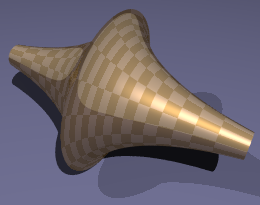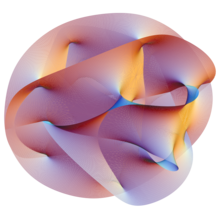钟形孤立子 正弦-戈尔登方程 是十九世纪发现的一种偏微分方程:
φ
t
t
−
φ
x
x
=
sin
φ
{\displaystyle \varphi _{tt}-\varphi _{xx}=\sin \varphi }
来自下面的拉量 :
L
=
1
2
(
φ
t
2
−
φ
x
2
)
+
cos
φ
{\displaystyle {\mathcal {L}}={\frac {1}{2}}(\varphi _{t}^{2}-\varphi _{x}^{2})+\cos \varphi }
由于正弦-戈尔登方程有多种孤立子 解而倍受瞩目。
名字是物理家熟悉的克莱因-戈尔登方程 (Klein-Gordon)的双关语。[ 1]
利用分离变数法 可得正弦-戈尔登方程的多种孤立子解。[ 2]
p
1
:=
−
4
∗
a
r
c
t
a
n
(
(
1
/
2
)
∗
(
1.5
∗
e
x
p
(
−
4
∗
s
q
r
t
(
2
)
)
−
e
x
p
(
2
∗
x
∗
s
q
r
t
(
2
)
)
)
∗
e
x
p
(
t
−
2
−
x
∗
s
q
r
t
(
2
)
+
2
∗
s
q
r
t
(
2
)
)
∗
s
q
r
t
(
2
)
/
(
1.5
∗
e
x
p
(
−
4
)
+
e
x
p
(
2
∗
t
)
)
)
{\displaystyle p1:=-4*arctan((1/2)*(1.5*exp(-4*sqrt(2))-exp(2*x*sqrt(2)))*exp(t-2-x*sqrt(2)+2*sqrt(2))*sqrt(2)/(1.5*exp(-4)+exp(2*t)))}
p
2
:=
−
4
∗
a
r
c
t
a
n
(
(
1
/
2
)
∗
(
1.5
∗
e
x
p
(
2
∗
x
∗
s
q
r
t
(
2
)
)
−
e
x
p
(
−
4
∗
s
q
r
t
(
2
)
)
)
∗
e
x
p
(
t
−
2
−
x
∗
s
q
r
t
(
2
)
+
2
∗
s
q
r
t
(
2
)
)
∗
s
q
r
t
(
2
)
/
(
1.5
∗
e
x
p
(
2
∗
t
)
+
e
x
p
(
−
4
)
)
)
{\displaystyle p2:=-4*arctan((1/2)*(1.5*exp(2*x*sqrt(2))-exp(-4*sqrt(2)))*exp(t-2-x*sqrt(2)+2*sqrt(2))*sqrt(2)/(1.5*exp(2*t)+exp(-4)))}
Sine-Gordon kink soliton plot1 Sine-Gordon kink soliton plot2
正弦-戈尔登方程有如下孤立子解:
φ
soliton
(
x
,
t
)
:=
4
arctan
e
m
γ
(
x
−
v
t
)
+
δ
{\displaystyle \varphi _{\text{soliton}}(x,t):=4\arctan e^{m\gamma (x-vt)+\delta }\,}
其中
γ
2
=
1
1
−
v
2
.
{\displaystyle \gamma ^{2}={\frac {1}{1-v^{2}}}.}
顺时针孤立子 反时针孤立子
p
x
1
:=
(
8
∗
(
1.5
∗
e
x
p
(
−
4
)
+
e
x
p
(
2
∗
t
)
)
)
∗
e
x
p
(
t
−
2
−
x
∗
s
q
r
t
(
2
)
+
2
∗
s
q
r
t
(
2
)
)
∗
(
e
x
p
(
2
∗
x
∗
s
q
r
t
(
2
)
)
+
1.5
∗
e
x
p
(
−
4
∗
s
q
r
t
(
2
)
)
)
/
(
4.50
∗
e
x
p
(
−
8
)
+
2
∗
e
x
p
(
4
∗
t
)
+
2.25
∗
e
x
p
(
2
∗
t
−
4
−
2
∗
x
∗
s
q
r
t
(
2
)
−
4
∗
s
q
r
t
(
2
)
)
+
3.0
∗
e
x
p
(
2
∗
t
−
4
)
+
e
x
p
(
2
∗
t
−
4
+
2
∗
x
∗
s
q
r
t
(
2
)
+
4
∗
s
q
r
t
(
2
)
)
)
{\displaystyle px1:=(8*(1.5*exp(-4)+exp(2*t)))*exp(t-2-x*sqrt(2)+2*sqrt(2))*(exp(2*x*sqrt(2))+1.5*exp(-4*sqrt(2)))/(4.50*exp(-8)+2*exp(4*t)+2.25*exp(2*t-4-2*x*sqrt(2)-4*sqrt(2))+3.0*exp(2*t-4)+exp(2*t-4+2*x*sqrt(2)+4*sqrt(2)))}
p
x
2
:=
−
(
8
∗
(
1.5
∗
e
x
p
(
2
∗
t
)
+
e
x
p
(
−
4
)
)
)
∗
e
x
p
(
t
−
2
−
x
∗
s
q
r
t
(
2
)
+
2
∗
s
q
r
t
(
2
)
)
∗
(
1.5
∗
e
x
p
(
2
∗
x
∗
s
q
r
t
(
2
)
)
+
e
x
p
(
−
4
∗
s
q
r
t
(
2
)
)
)
/
(
4.50
∗
e
x
p
(
4
∗
t
)
+
2
∗
e
x
p
(
−
8
)
+
2.25
∗
e
x
p
(
2
∗
t
−
4
+
2
∗
x
∗
s
q
r
t
(
2
)
+
4
∗
s
q
r
t
(
2
)
)
+
3.0
∗
e
x
p
(
2
∗
t
−
4
)
+
e
x
p
(
2
∗
t
−
4
−
2
∗
x
∗
s
q
r
t
(
2
)
−
4
∗
s
q
r
t
(
2
)
)
)
{\displaystyle px2:=-(8*(1.5*exp(2*t)+exp(-4)))*exp(t-2-x*sqrt(2)+2*sqrt(2))*(1.5*exp(2*x*sqrt(2))+exp(-4*sqrt(2)))/(4.50*exp(4*t)+2*exp(-8)+2.25*exp(2*t-4+2*x*sqrt(2)+4*sqrt(2))+3.0*exp(2*t-4)+exp(2*t-4-2*x*sqrt(2)-4*sqrt(2)))}
Sine-Gordon colliding soltons plot1 Sine-Gordon colliding soltons plot2
Sine-Gordon bright & dark solitons plot1 & dark solitons plot2
扭型与反扭型碰撞 扭型-扭型碰撞
扭型行波呼吸子与驻波呼吸子碰撞 反扭型行波呼吸子与驻波波呼吸子碰撞
正弦-戈尔登方程的呼吸子解
u
=
4
arctan
(
1
−
ω
2
cos
(
ω
t
)
ω
cosh
(
1
−
ω
2
x
)
)
,
{\displaystyle u=4\arctan \left({\frac {{\sqrt {1-\omega ^{2}}}\;\cos(\omega t)}{\omega \;\cosh({\sqrt {1-\omega ^{2}}}\;x)}}\right),}
p
z
1
:=
4
∗
a
r
c
t
a
n
(
(
28.460498941515413988
∗
(
e
x
p
(
1.8973665961010275992
∗
x
)
+
s
q
r
t
(
e
x
p
(
3.7947331922020551984
∗
x
)
)
)
)
∗
s
i
n
(
O
m
e
g
a
T
)
∗
c
s
g
n
(
1
/
c
o
s
(
O
m
e
g
a
T
)
)
∗
e
x
p
(
−
.94868329805051379960
∗
x
)
/
(
18.
+
5.
∗
e
x
p
(
1.8973665961010275992
∗
x
)
)
)
{\displaystyle pz1:=4*arctan((28.460498941515413988*(exp(1.8973665961010275992*x)+sqrt(exp(3.7947331922020551984*x))))*sin(OmegaT)*csgn(1/cos(OmegaT))*exp(-.94868329805051379960*x)/(18.+5.*exp(1.8973665961010275992*x)))}
p
z
2
:=
4
∗
a
r
c
t
a
n
(
(
28.460498941515413988
∗
(
e
x
p
(
1.8973665961010275992
∗
x
)
+
s
q
r
t
(
e
x
p
(
3.7947331922020551984
∗
x
)
)
)
)
∗
s
i
n
(
O
m
e
g
a
T
)
∗
c
s
g
n
(
1
/
c
o
s
(
O
m
e
g
a
T
)
)
∗
e
x
p
(
−
.94868329805051379960
∗
x
)
/
(
18.
+
5.
∗
e
x
p
(
1.8973665961010275992
∗
x
)
)
)
{\displaystyle pz2:=4*arctan((28.460498941515413988*(exp(1.8973665961010275992*x)+sqrt(exp(3.7947331922020551984*x))))*sin(OmegaT)*csgn(1/cos(OmegaT))*exp(-.94868329805051379960*x)/(18.+5.*exp(1.8973665961010275992*x)))}
Sine-Gordon breather plot1 Sine-Gordon breather plot2
三维欧几里德空间的负常曲率曲面 根据陈省身 的研究,正弦-戈尔登方程有一个几何解释:三维欧几里德空间 的负常曲率 曲面(伪球面 )。[ 3]
正弦-戈尔登方程是:[ 4]
φ
t
t
−
φ
x
x
=
sinh
φ
{\displaystyle \varphi _{tt}-\varphi _{xx}=\sinh \varphi }
跟户田场论 [ 5]
正弦-戈尔登是Thirring模特 S对偶 。
半经典量子化:[ 6]
^ Rajaraman, R. Solitons and instantons : an introduction to solitons and instantons in quantum field theory. Amsterdam https://www.worldcat.org/oclc/17480018 . (1987 [printing]). ISBN 0-444-87047-4OCLC 17480018 ^ Inna Shingareva Carlos Lizarraga Celaya, Solving Nonlinear Partial Differential Equations with Maple and Mathematica, p86-94,Springer
^ 陈省身 Geometrical interpretation of the sinh-Gordon equation。annals Polonici Mathematici XXXIX 1981^ Poli︠a︡nin, A. D. (Andreĭ Dmitrievich). Handbook of nonlinear partial differential equations. 2nd ed. Boca Raton, FL: CRC Press https://www.worldcat.org/oclc/751520047 . 2012. ISBN 978-1-4200-8723-9OCLC 751520047 ^ Xie, Yuanxi; Tang, Jiashi. A unified method for solving sinh-Gordon-type equations . Il Nuovo Cimento B. 2006-05-10, 121 (2): 115–120. ISSN 0369-3554 doi:10.1393/ncb/i2005-10164-6 ^ Faddeev, L.D.; Korepin, V.E. Quantum theory of solitons . Physics Reports. 1978-06, 42 (1): 1–87 [2020-02-03 ] . doi:10.1016/0370-1573(78)90058-3 存档 于2021-03-08) (英语) .
Bour E (1862). "Théorie de la déformation des surfaces" (页面存档备份 ,存于互联网档案馆 ). J. Ecole Imperiale Polytechnique. 19: 1–48.
Rajaraman, R. (1989). Solitons and Instantons: An Introduction to Solitons and Instantons in Quantum Field Theory. North-Holland Personal Library. 15. North-Holland. pp. 34–45. ISBN 978-0-444-87047-6 .
Polyanin, Andrei D.; Valentin F. Zaitsev (2004). Handbook of Nonlinear Partial Differential Equations. Chapman & Hall/CRC Press. pp. 470–492. ISBN 978-1-58488-355-5 .
Dodd, Roger K.; J. C. Eilbeck, J. D. Gibbon, H. C. Morris (1982). Solitons and Nonlinear Wave Equations. London: Academic Press. ISBN 978-0-12-219122-0 .
Georgiev DD, Papaioanou SN, Glazebrook JF (2004). "Neuronic system inside neurons: molecular biology and biophysics of neuronal microtubules". Biomedical Reviews 15: 67–75.
Georgiev DD, Papaioanou SN, Glazebrook JF (2007). "Solitonic effects of the local electromagnetic field on neuronal microtubules". Neuroquantology 5 (3): 276–291.
基本对象 背景理论 微扰弦理论 非微扰结果 现象学 数学方法 几何 规范场论 超对称 理论家


































